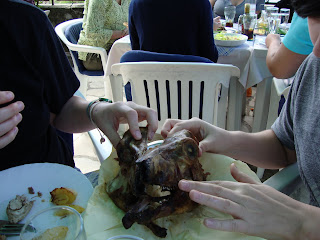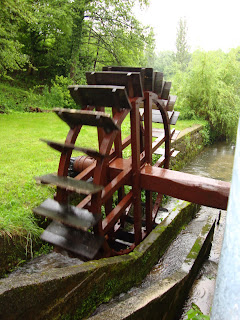Ben: We started the day bright and early with a (very) brisk walk to the Faculty of Architecture (
Colin - a "Faculty" is what in the U.S. we would call a "Department") for the University of Zagreb to hear some local students give presentations on ideas for rebuilding Vukovar (pronounced VOO-co-var), which we will be visiting in a few days. The students did an outstanding job (even though they looked terrified to speak in front of us). After the presentations, everyone was free for the day except the public health students. We had another lecture to attend at the Stampar Institute. We met Dr. Zdenko Sonicki, who gave a lecture on some special cases of health issues in a particular region in Croatia. He did a great job, and the material was very interesting. After the lectures, we had a short class and then were free for the day. I was not in attendance at this class because I had a meeting to attend, which I will now tell you about.

As I stated in our first posting, I will be reporting to you all on my findings about pharmacy in Croatia. Well, thanks to our amazing guide/translator/liaison Juraj, I was set up with an appointment to meet a local pharmacist who turned out to be the director of the City Pharmacy of Zagreb’s laboratories. She oversaw the labs that produced many different herbal and homeopathic medication applications (creams, ointments, balms, capsules, tablets, etc.) In Croatia, this is actually controlled by the Government, but more on that later. I met with Mr. Pharm. Spec. Maja Bernasek * for a little over 2 hours last Friday (pictured on the left), and I am beyond grateful for her time. Before I go off on a tangent about everything I learned in my meeting, I feel like I should give you a breakdown of how I’m going to break this down. I took a few pages of notes during my meeting, enough for a few posts in fact. So, instead of making one gigantic update, I am going to break my information into sections, and work it into my understanding of public health as best I can.
Ok, so with that said, today I’m going to start with giving you a wide-scale view of the pharmacy industry in Croatia, and do a little comparison to the American system. The Croatia pharmacy industry has two basic components: Industrial Pharmacy, which covers drug production and national distribution, and Pharmacy, which is practically everything else (retail, hospital, long term care, etc.). Drug production occurs in only 3 factories in Croatia: in Belupo, Pliva, and Jagdren. The industrial side of things is controlled by the Agency for Drugs, which is a loose counterpart for the FDA in America. They oversee drug production and ensure quality and safety in the drug supply. Since Croatia is such a small country, they can’t make 100% of the drugs they need for their citizens. Because of this, they import many drugs from other countries, not only from Europe but from America too. There is a government agency associated with the national social insurance in Croatia (I apologize, because I didn’t catch the name of this agency/ministry) that has developed a list of every drug that is approved for use in the country. What makes this interesting is that the agency that provides insurance to the entire population is also the one in charge of approving these drugs, and because of this, every prescription drug is covered by insurance! There still might be a co-pay from time to time, but they never have to worry about not being able to afford a drug because it isn’t covered by their insurance plan (the insurance does not cover OTC meds though). Easy public access to medications, especially when they are guaranteed to be covered by insurance, is an excellent way to bolster and improve public health.
Well, because there’s only so much you can stand to read about pharmacy in a foreign country in one day, I’ll cut this post off here for today. I’ve got a lot more to write up, so keep a look out for the next one.
* - Mr. Pharm. Spec. is the title given to pharmacists in Croatia. I believe it stands for Magister Pharmacy Specialist. This is not equivalent to a doctorate in Croatia. For comparison, in America, Pharmacists are now given the title of Pharm D., which is Doctor of Pharmacy. The lack of a "doctor" title can have a large effect on how pharmacists are viewed in this country, and what people will use them for.Colin: This evening we had a chance to go visit an anarcho-punk artist "squat-house", an underground establishment that was semi-legal, made up of unemployed artists, street musicians, and supporters who live in an abandoned factory that taps into the electrical power of a neighboring youth center, but the government is currently turning a blind-eye because of the stable nature of the community. One of the things that we have noticed on our exploration of Zagreb was the amount of graffiti (something I also noticed in Vienna and Ljubljana on my trip to Croatia). We were told that much of this "tagging" was the result of disaffected unemployed youth. Here was a place where those with artistic ability could come and express themselves. We were able to see this sanctuary, and interact with its inhabitants, thanks to the efforts of Pillar Institute researchers Dr. Ben Perasovik and his research assistant Ivana, without whom this never would have happened.



























